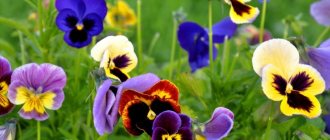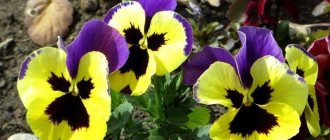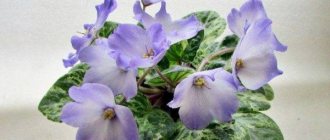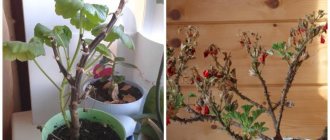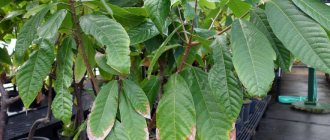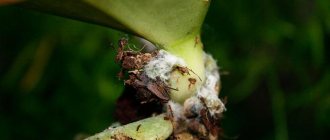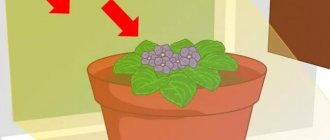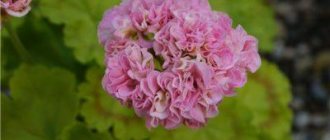Venerable orchid growers will read this article only out of boredom. Those who do not seek to fill their window sills with collectible material, but are simply in love with it, Miltonia, the only one received as a gift or “caught on” in a store window, will be able to learn something useful. Caring for a plant at home will be much easier if you first become familiar with the requirements that an exotic orchid makes for the microclimate, substrate, and watering regime. There are other important nuances, knowledge of which will help a novice gardener.
Description and features
Miltonia is a sympodial epiphytic orchid. This means that in nature it lives on trees, has pronounced aerial roots, and forms lateral shoots with pseudobulbs for independent reproduction.
Miltonia leaves are long and belt-shaped. The color is not typical for orchids - grayish or yellowish. Flowers come in a variety of colors, sometimes combining several contrasting colors. The petals often have a pattern resembling the wings of butterflies.
An adult miltonia can throw out several peduncles at once, covered with blossoming flowers and buds. Flower growers often call miltonia pansies for their similarity in shape and color.
Interesting varieties
In total there are about 20 varieties of miltonia. Not all received distribution. The following types are most often found in apartments.
- Brilliant. Pseudobulbs are slightly elongated, flattened. The leaves are belt-shaped, yellowish in color. A fairly unpretentious variety - it can easily withstand heat and cold. It blooms with large white flowers with a yellowish tint. Less common is a pinkish color with purple streaks. Flowering occurs at the end of summer.
- Yellowish. A variety of Miltonia native to Argentina. Pseudobulbs bifoliate. Up to 14–15 large flowers bloom on one peduncle. The color is yellowish-white, often with a contrasting pattern. Blooms for a long time - from the beginning of spring almost until autumn.
- Snow-white. The pseudobulb produces one or two peduncles. Up to five flowers bloom on each peduncle. It has a pleasant aroma.
- Regnelli. Feature: thin glossy leaves. The flowers are large, white, fragrant. Each peduncle bears up to six flowers. The pink lip with purple stripes stands out clearly.
An interesting hybrid of Brassia and Miltonia deserves special attention. They called it Miltassia. It is distinguished by fancy elongated petals. From a distance, miltassia flowers resemble not fluttering butterflies, but spiders with long legs.
Camellia sinensis
The homeland of this plant is the subtropical and tropical mountain forests of Indochina. It is a small tree or shrub up to 10 m tall with spaced shoots. The leaves are ordinary, oblong-oval, narrowed upward, short-petioled. They are dark green on the outside, light green underneath, 5-7 cm long and 3-4 cm wide. Young leaves are slightly pubescent. The pulp of the leaves contains spreading bearing sclereids.
The flowers are solitary, fragrant, or found in groups of 2-4 in the recesses of the leaves. Flower leaves and bracts are arranged along a curve. The calyx is fused-leaved, has 5-7 rounded sepals, which are preserved during the fruit. The corolla of the plant is 2.5-3 cm in diameter and falls off after flowering. Contains from 5 to 9 white petals with golden-pink color, connected to each other and to the calyx in the center. The stamens are located in two rings: the outer ones are fused with stamen filaments and attached to the petals, the lower ones are independent with small ovoid anthers. The gynoecium is syncarpous with columns connected to the core.
Camellia japonica (Chinese) has fruits in the form of flattened tricuspid woody boxes. Their seeds are rounded, dark chestnut in color, 10-13 mm in length, 1 mm in thickness. Blooms from early August until the end of autumn. Harvests in October-December.
Features of caring for miltonia
How to care for miltonia? Like all orchids, miltonia requires special, careful care. When growing it, you need to adhere to a number of rules.
- Lighting. Compared to other types of orchids, it is less sensitive to light levels. Grows well in bright, indirect light on windowsills. It easily tolerates a little partial shade - miltonia can be placed slightly away from the window on tables and cabinets. Do not place it in the open sun - the leaves get burned, the flowers become discolored. In strong shade, growth slows down and flowering stops. The pinkish tint of miltonia leaves indicates that the lighting has been chosen correctly.
- Temperature. The optimal temperature for growing miltonia is 15-18°C in winter and 18-20°C in summer. These are recommended but not required settings. The orchid gradually adapts to the microclimate of the apartment and reacts normally to higher temperatures. Miltonia really does not like sudden temperature changes. The room is systematically ventilated, avoiding the formation of drafts.
- Humidity. Dry air and its stagnation have a detrimental effect on miltonia - the leaves dry out, the flowers fall off. It is recommended to maintain humidity at 65–80%. A special humidifier is installed next to the plant, and in winter the batteries are covered with a wet cloth. Spraying miltonia and the air around it has a good effect.
- Feeding. Fertilizers are applied mainly at the stage of bud formation and during flowering. Take a special product for orchids and reduce the concentration by half. Added every two weeks. You can feed miltonia in two ways - by watering at the root or spraying the leaves. Alternating these two methods gives a good effect.
- The soil. Miltonia needs special soil. It is made from crushed bark of coniferous trees, fern roots and peat. For looseness, add 5–10% polystyrene foam. You can use special soils for orchids.
- Transfer. Miltonia does not like unnecessary interventions - they try not to disturb the flower unless necessary. You can replant miltonia if the roots are breaking through the drainage holes or the soil has compacted and turned to dust. When replanting, the root system is carefully inspected and freed from the remnants of the old soil mixture. Roots that are too long are trimmed and diseased and dried out ones are removed. All sections are treated with charcoal powder.
- Container for planting. A large pot is not needed - miltonia prefers a slightly cramped environment. Unlike phalaenopsis, it is not necessary to use a transparent pot.
How to care for miltonia after transplantation? For the first ten days, the transplanted orchid is shaded from bright light. The first watering is carried out immediately after transplantation. For irrigation, use warm, settled water with the addition of a small amount of fertilizer. Watered using the immersion method - the pot is immersed in the nutrient mixture for about half an hour. After this, watering is stopped for two weeks. The next feeding is only in three weeks.
Watering
Miltonia is watered abundantly only in the warm season, when it grows and blooms intensively. Excessive watering is avoided. Miltonia should be watered so that the substrate always remains moist. Drying out and stagnant moisture are equally destructive. Two methods of watering are used.
- By immersion. The most common watering method. The pot is placed in a basin with lukewarm water. The liquid should not fall on the substrate - water is poured into the basin just below the level of the edge of the pot. Keep in water until the substrate is completely saturated with moisture. Usually 15-20 minutes is enough. The pot is taken out, placed on a wire rack to drain excess liquid and the plant is returned to its place.
- Top watering. Miltonia is watered from a warm shower, simulating tropical rain. The optimal water temperature is 30-40°C. After the shower, dry the flower and remove any remaining moisture from the axils of the leaves.
In winter, water less often - only if absolutely necessary. During cool wintering, overhead watering is not used; watering is only done by immersion.
Soil requirements
Camellia japonica, about which you can hear only good reviews, loves acidic soils. And that’s why for its flowering and development, special earthen mixtures made from well-sifted sand and peat are needed. Mixtures for rhododendrons are great because they can absolutely satisfy all the needs of the plant.
Separately prepared soil mixtures have a slightly acidic reaction. This means that they do not contain lime. In addition, when watering flowers, there should be no calcium salts in the water. Therefore, before irrigation, it is necessary to infuse water for half a day if it is not possible to use filtered water.
Flowering and dormant period
With good care, miltonia blooms twice a year. At the same time, the plant produces up to three peduncles with fragrant large flowers. Each hybrid Miltonia variety has its own shade and pattern.
Flowering lasts up to two months. Proper care of miltonia during flowering allows you to see new flower stalks on the plant after a couple of months of rest. During flowering, they try not to disturb miltonia unnecessarily; they regularly apply fertilizers. They protect from direct sun and try to maintain constant microclimate parameters.
Cut off flower stalks immediately after wilting. They cut almost to the root without injuring the pseudobulb. The orchid will rest for two months. Miltonia is transferred to a cool place and watering is reduced. After new flower stalks appear, they return to standard care.
Without a dormant period, miltonia will not form flower arrows. Lack of rest is one of the most common mistakes novice gardeners make.
Temperature
Camellia in spring and summer prefers an air temperature of at least 20-25 degrees. To set buds, you need a temperature of 18-20 degrees, and during the blooming period in December-February - 9-12 degrees. At increased temperatures, flowering begins earlier, but the quality of the flowers will be much worse, and there is a risk that the Japanese camellia will shed its buds. Caring for the plant in such a situation will no longer be appropriate.
Subtleties of reproduction
Miltonia produces babies extremely rarely; pseudobulbs take root poorly, so it is propagated only by dividing the bush. Divide the bush at the same time as replanting. The flower at the time of division must be mature, healthy and have at least six pseudobulbs. The division is carried out in four stages.
- Miltonia is removed from the pot, and the remaining soil is removed from the roots.
- Use a sharp sterile knife to cut the bush. On each division, three pseudobulbs and a formed root system are left. The sections are treated with charcoal powder.
- The delenki are left to dry for five hours, then they can be planted in separate pots. Do not deepen the roots too deeply - this is fraught with the development of rot.
- In the first three weeks, moderate watering is maintained. Restrained growth of miltonia in the first weeks after division is normal.
Dividing miltonia too often is not recommended. Large bushes develop better, bloom more profusely, and are less susceptible to diseases and pests.
Fertilizers for Miltonia
Complex mineral fertilizers contain a certain set of micro- and macroelements in different concentrations. Each of these substances is responsible for certain processes. A deficiency or excess of this affects the appearance of the plant, the intensity of flowering and growth. In the table you can familiarize yourself with all the substances vital for miltonia, their role in the life of the flower, signs of deficiency or excess.
Table - Substances necessary for miltonia
| Substance | Its functions | a lack of | Excess |
| Nitrogen | — Synthesis of protein compounds; — active growth | — Shredding, lethargy of leaves; - yellow, marbled leaves; - accelerated drying of old foliage | — Very fast growth; - lack of flowering; - softening and cracking of the fabric |
| Phosphorus | — Regulation of cell division; - flowering; - seed ripening | — Weakening of the plant; - curvature of young shoots; - faded, reddish tint of leaves; - lack of flowering | - Blackening of leaf tips |
| Potassium | — Metabolism; - photosynthesis; — saturation of cells with moisture; - plant immunity | - General weakening; - growth arrest; - decrease in turgor; - dark green leaves with yellowish edging; - marbling | — Blockage of nitrogen supply (nitrogen deficiency) |
| Calcium | — Cell division; - root formation | — Weakening of plant tissues | — Deformation of new shoots |
| Magnesium | - Production of chlorophyll; - regulation of water flow | - Yellow spots that turn black over time | — Potassium deficiency |
| Iron | — Photosynthesis; - converting nitrogen into an easily digestible form | — Yellowing of the veins of young leaves; - spots on the leaves (veins are not affected); - dying of leaves from the edges; - slow growth | — Slowdown of development; - lack of flowering |
| Zinc | — Synthesis of enzymes and chlorophyll | — Not found in practice | — Marbling of leaves; - inhibition in development; - lack of flowering; - leaf deformation |
| Copper | — Formation of enzymes; - increased immunity | — Leaf curvature; - lack of flowering | — Growth slowdown; - reddish tint of leaves |
Judging by the reviews of experienced gardeners, you need to use only special fertilizers for orchids in half the dosage and strictly adhere to the feeding schedule.
Camellia montana
Its bush grows up to 3-4 m in height, with thin branches and bright red pubescent flowers. The leaves are elliptical or elongated oval in shape, 3-6 cm long, 1.5-3 cm wide. Their tops are slightly sharp, the edges are finely toothed, the outside is dark green and glossy, the inside is hairy-pubescent with a vein.
The flowers are single or connected in 2-3 pieces, 6-7 cm in diameter, ordinary white, red or pink, with a scent. They bloom well in November-January. As blooming evergreen crops, gardeners usually propagate garden varieties. Camellia japonica (mountain) is also suitable for cold rooms.
Common care mistakes
Growing any orchid is a complex process that requires certain knowledge and skills. Beginners often make mistakes that lead to illness and loss of flower decorativeness. Information from the table will help determine what happened to miltonia.
Table - Consequences of improper care for miltonia
| Problem encountered | Probable Cause |
| Unopened buds fall | — Cold draft; - heat; - dry air |
| Flowering becomes short | — Short period of rest; - lack of nutrients; - heat; - action of the open sun |
| Miltonia leaves turn yellow | — Lack or excess of nutrients; - rotting of the root system |
| Black spots appear on pseudobulbs and leaves | — Regular waterlogging of the substrate in combination with cold or drafts |
| Leaves become pale | — Lack of nutrients; - excess light |
| The leaves are darkening | — Poor lighting |
| Leaves wither and wrinkle | - Narrow pot; - irregular watering |
| Small black spots appear | — Water stagnation |
| Light translucent spots appear | — Sunburn |
| The tips of the leaves dry out | — Soil salinization; - dry air |
An orchid can shed buds and leaves if ripe fruits lie next to it. Ripe apples, pears and bananas release ethylene into the air. This substance is very harmful to flowers.
Major diseases
With good care, diseases do not occur very often. The slightest care errors weaken miltonia and make it susceptible to fungi and viruses. The table contains the main diseases that flower growers have to deal with, as well as their symptoms and treatment.
Table - Main diseases of miltonia
| Name of the disease | External manifestations | Treatment options |
| Leaf spot | — Elongated yellow spots that turn brown over time | - Cannot be treated (destroyed) |
| Bronzing of leaves | — Leaf deformation; - ugliness; - brown, randomly located spots | - Cannot be treated (destroyed) |
| Rot of the stem base | — Whitening and rot of the pseudobulb | — Diseased pseudobulbs are removed; - cut out diseased areas, treat the sections with coal powder and fungicide; - transplanted |
| Fusarium rot | — Fading and yellowing of individual leaves; - whitish with a pink tint on the root collar | — Replant with cutting out damaged areas; - repeatedly treated with fungicides |
| Anthracnose | - Dark sunken spots | — Cut out the affected areas; - treated with fungicides; - temporarily reduce air humidity |
| Leaf spot | — Black-brown spots of small size; - yellowing of leaves | — Cut out diseased parts of the plant; - miltonia is dried and replanted |
| Gray rot | - Flowers become speckled; - softness and wateriness of tissues; - moldy gray coating | — Remove the affected areas; - temporarily reduce humidity - treat with fungicides |
| Bacterial rot | — Fading and rotting of leaves | Not subject to treatment (destroyed) |
| Late blight | — Withering and drying of individual parts of the plant; - rot from the base of the stem | — Diseased areas are cut out and treated with fungicides (the likelihood of recovery is very low) |
| Root rot | — Dullness and pale color of leaves; - softening, rotting of roots; - “frayed” roots | — Replant with removal of the affected parts; - reduce watering; - repeated treatment with fungicides |
| Brown rot (Only young plants up to several weeks old are affected) | — Thinning, browning of the base of the stem | - Cannot be treated (destroyed) |
| Cercospora | — Yellow spots along the edge of the reverse side of the sheet; - addition of black, purple, red-brown spots; - falling of diseased leaves | — Affected leaves are removed; - limit watering; - reduce air humidity; - sprayed with Mancozeb fungicide |
Typical pests
Miltonia is attacked by the same pests as other types of orchids. Their appearance is provoked by dry air, proximity to infected plants, and violation of care conditions. Most of them feed on the sap of the plant, which leads to its weakening. Information about the main pests and methods of controlling them is given in the table.
Table - Main pests of Miltonia
| Pest | How to detect | What to do |
| Thrips | — Uneven yellowish-white coloring of individual sections of leaves; - insect secretions in the form of dark dots; - drying and falling of leaves; - dried spots on the edges of the petals | — Repeated treatment with the preparations “Aktara”, “Fufanon”, “Iskra”, “Tanrek” |
| Spider mite | - Yellow specks; - large faded areas; - cobwebs on the back of leaves | — Treatment with soap solution or mineral oil; — increase in humidity; — treatment with acaricides “Akarin”, “Vermitek”, “Molniya” |
| Shields | - Light spots on the leaves; — insects in brown scutes; - transparent sticky coating; - secondary attachment of sooty fungus | — Lubricating areas with insects with vegetable oil; — manual removal of insects; - treatment with Actellik or Karbofos |
| Chervetsy | — Waxy discharge on petioles and veins | — Spraying with mineral oil |
| Aphids | - Sticky discharge; - curling and yellowing of young leaves | — Washing with soapy water; - spraying with infusion of tobacco dust or any insecticide |
Camellia oleifera
This variety of crop is found in forests and on the banks of rivers in China at elevations from 500 to 1300 m above the sea surface. The oil plant is an evergreen tree up to 10 m in height. The trunk is covered with a brown crust, its diameter is up to 20 cm. The leaves are leathery, ordinary, petiolate, alternate, ovoid, pointed at the apex. The flowers are white, bisexual, paired, axillary or single, appearing in September. Their blooming time lasts until mid-October. Camellia japonica (oleiferous) is distinguished by its fruit in the form of a large capsule with many spherical seeds up to 3 cm long.
If the roots have rotted...
Root rot is a problem not only for miltonia, but also for other types of orchids. It happens that the plant is left completely without roots. What to do in such cases? Is it possible to save miltonia? Below is a step-by-step description of the method for resuscitating miltonia roots. Proceed in five steps.
- Remove the orchid from the pot and remove any rotten roots.
- Immerse the miltonia rosette in a 2% solution of any fungicide for ten minutes.
- Dust all sections with charcoal powder or crushed chalk and leave to dry for five hours.
- Fill the container with warm water. Set miltonia in it for 6 hours. There is no need to completely immerse the flower in water - only its base should touch the liquid.
- After six hours, remove the miltonia and leave it to dry until the next morning.
This procedure must be repeated every morning until the length of the young roots reaches 4-5cm. After the roots grow, the reanimated miltonia is transplanted into the ground.
A little tip - add a little honey or sugar syrup to the water. This will significantly speed up the process of restoring the root system.
Growing miltonia at home is an excellent choice for beginners who have not yet had to deal with orchids. Compared to most types of orchids, miltonia is relatively unpretentious and resistant to diseases and pests.
Landing
When buying camellia seedlings in the fall, in winter they are stored in a container indoors and planted in the ground only the next season.
The optimal time for planting camellias in open ground is spring, from mid-April to mid-June.
When planting, you need to pay special attention to the depth - a root ball planted too deeply is unfavorable, and the bush may not bloom. The planting needs to be shallow so that the first roots connecting to the stem are visible.
Planting garden camellia step by step:
- A hole for the seedling is dug twice as wide as the root ball.
- You should mix garden soil with peat, compost and pour it into the bottom of the hole.
- After placing the seedling in a hole, you need to make sure that the tops of the roots protrude 1-2 cm above the soil surface - over time, the bush will settle anyway.
- After planting, you need to water the plant abundantly and mulch the soil with bark.
